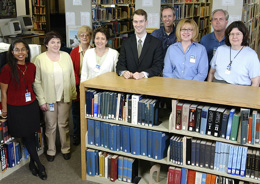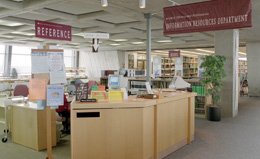 |
|
Quiet: Librarians at Work by Sena Desai
The silence is broken by an occasional subdued cough or the clicking of a printer. All seems calm in Fermilab’s library as Sue Hanson,the administrative support assistant, helps people at the front desk;or as Sandra Lee,the librarian, quietly puts books back on shelves. But beneath this calm surface on the third floor of Wilson Hall,the nine people in the Information Resources Department are working tirelessly to put the library on the map as a provider and controller of physics-related information. Last year,Fermilab’s IRD began storing its information and literature in the Stanford Linear Accelerator Center database,the Stanford Public Information Retrieval System. The shift to SPIRES has cut expenses for Fermilab and IRD has become more efficient,evolving into a “virtual library ”accessible from anywhere in the world. In light of the broad capabilities afforded by Internet searching,the role of library services like the IRD may seem defunct. But an untold amount of information cannot be accessed through search engines like Google. Getting to this second level of information requires the expertise and training of a librarian. As more and more information is stored in more and more places on the Web,the role of library services like the IRD becomes even more crucial and complex — they now have to train their people to store information in computer databases rather than bookshelves, and more importantly,train them to find this information when their patrons need it. Fermilab’s IRD has two groups working closely together.While the library group brings outside information to Fermilab, the technical publications group collects information from Fermilab, catalogs it, and archives it for use by the rest of the world. Until last year, IRD contracted with several outside commercial database systems for storing and accessing its information.Using contractors meant Fermilab did not need experts trained in the working of any particular database system. But it was also more expensive,and with less control over information, than if IRD had owned its database. Over the years, many physics laboratories around the world have partnered with SLAC to use SPIRES as their own database.They can enter and access information directly through SPIRES, giving them complete control over their information.When Heath O’Connell took over as IRD’s manager last year, Fermilab became the newest partner. O ’Connell, a physicist who managed the SPIRES database at SLAC before coming here,was aware of the good things this database could do for Fermilab. Soon after his arrival here,he worked with SLAC so Fermilab could use the SPIRES database.“I have been interested in adopting the SLAC model to have ownership of our data,”he says.“And I have been interested in developing the expertise in people within our library so they understand our database completely.”
SPIRES was first conceived because researchers like to bounce papers off their peers for feedback before submitting them to journals.And physicists around the world have always sent copies of their papers to prime physics locations like SLAC and Fermilab. In 1962,at the request if its first director, W.K.H.Panofsky, SLAC began cataloging information of pre-prints it received. At the time, Stanford was developing a database in which the pre-print information was entered —the earliest version of SPIRES,accessible through Stanford ’s computing system. But it was only with the advent of the Internet that people from around the world could access SPIRES.When physicists started sending their articles electronically via email,the e-print evolved. The SPIRES database, now housing almost 500,000 articles, motivated the creation of the first site in the country for the World-Wide Web. The Internet encouraged partnerships between SLAC and other laboratories, making SPIRES a world center for physics information. But there were problems with the huge amount of information coming in. “People were emailing their papers all over the place,” says O ’Connell.“And it was a jumble.” Paul Ginsparg, a theoretical physicist at Los Alamos National Laboratory, created an archive for storing e-prints, generating a daily list of the newest papers. Later,Ginsparg accepted a professorship at Cornell University and moved himself and the e-print archive there.The Cornell University archive is now a storehouse of full-text e-prints cataloged in SPIRES. Fermilab now not only hosts SPIRES on its server, but has gone a step ahead — it is also handling all the astrophysics e-prints.“In a sense it was natural that Fermilab should have control of this sub-field of physics because it has a lot of experience and expertise in the area,”says O’Connell. Since Fermilab took over,the astrophysics papers’ database has expanded. While SLAC cataloged only those astrophysics papers related directly to particle physics, Fermilab’s IRD catalogs a broader range of astrophysics papers.“The presence of a strong astrophysics community in Fermilab suggests that astrophysics and particle physics are becoming closer together,” says O’Connell. All this volume has increased the challenges for the IRD group. Kathryn Duerr,the library technician, now spends most of her time entering new astrophysics papers and updating older entries. Celina Paul,the interlibrary resources librarian, is pulling out the 28,000 astrophysics papers already in the archive, making the entries more comprehensive so they are easily accessible through SPIRES. And Kevin Williams,the computer professional, has worked with SLAC to set up SPIRES on the Fermilab server. Researchers at Fermilab first upload their papers in the technical publications group archive. But before the rest of the world sees the paper,Cyndi Rathbun, the technical information coordinator, sends it out for a patent review and for a peer review. If there are errors, the paper goes back to the author for changes, before it is finally posted on the SPIRES website for all to see. For the first time in the history of physics laboratories, Fermilab is systematically collecting and storing its doctoral theses on its own server. O’Connell says researchers were interested in reading details of other experiments available only as paper copies. Now the full theses are available online.
The book catalogs are still on a commercial database over which Fermilab has little control. But IRD is working on transferring the book catalogs to SPIRES.“At every step there are issues and problems,”says O ’Connell.“Not the least of them is getting information out of the commercial database.” But Rob Atkinson, who has cataloged books at IRD for 11 years, especially enjoys this new challenge because he was a computer science major.“When Heath came last year,he saw my academic background and decided to make use of it,”he says.The existing library catalog is converted to SPIRES using a language called Perl, which Atkinson is mastering so Fermilab ’s books can soon be in SPIRES. With the visual media services at SLAC,DESY, Santa Barbara Theoretical Institute,and Jefferson Laboratory among others,Atkinson is also building a database of streaming videos in SPIRES.And Jean Slisz,the web developer,has redesigned the IRD web pages,making them easier to navigate. Though they now have a lot more on their plates, the IRD group welcomes the changes. “We are becoming more visible in the physics community under Heath,”says Paul.“Before,we were just Fermilab and did our own thing.But now we are a part of SPIRES and actively providing information to the rest of the physics community.” Fermilab has always been at the forefront of physics research. It has now entered the 21st century adopting state of the art technologies to store and deliver its research to the world. “We used to write down everything on paper, then write it again and put it in the database,”says Rathbun.“Now we are doing things electronically in a faster and more efficient way.”
What your librarians can do for you
ON THE WEB: Library Website: http://library.fnal.gov Fermilab SPIRES: www-spires.fnal.gov/spires/hep |


